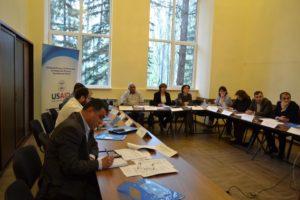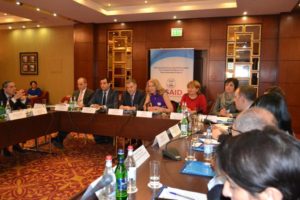 On November 9, the USAID Advanced Science and Partnerships for Integrated Resource Development Project (ASPIRED) organized the policy workshop to discuss the current situation with the groundwater resources in the Ararat Valley. The USAID Mission Director Deborah Grieser, the Minister, Chief of Staff Davit Harutyunyan, the Deputy-Ministers of Nature Protection, Agriculture, Energy Infrastructures and Natural Resources, other decision-makers, public and private sector representatives attended the event. In her opening remarks, the USAID Mission Director Deborah Grieser thanked the Government of Armenia and the stakeholders for continued partnership and commitment to promote water sector reforms and sustainable water management practices in Armenia. The Deputy Minister of Nature Protection Khachik Hakobyan emphasized that conservation of the groundwater resources of the Ararat Valley has strategic importance for the country and is among the priority issues the Government is tasked with.
On November 9, the USAID Advanced Science and Partnerships for Integrated Resource Development Project (ASPIRED) organized the policy workshop to discuss the current situation with the groundwater resources in the Ararat Valley. The USAID Mission Director Deborah Grieser, the Minister, Chief of Staff Davit Harutyunyan, the Deputy-Ministers of Nature Protection, Agriculture, Energy Infrastructures and Natural Resources, other decision-makers, public and private sector representatives attended the event. In her opening remarks, the USAID Mission Director Deborah Grieser thanked the Government of Armenia and the stakeholders for continued partnership and commitment to promote water sector reforms and sustainable water management practices in Armenia. The Deputy Minister of Nature Protection Khachik Hakobyan emphasized that conservation of the groundwater resources of the Ararat Valley has strategic importance for the country and is among the priority issues the Government is tasked with.
The situation with the groundwater resources in the Ararat Valley has been a topic of public discourse for the last couple of years. The field studies showed the artesian zone of the Ararat Valley has shrunk and the groundwater level in the Ararat Valley decreased significantly over the last decade due to uncontrolled use of groundwater in the area, primarily by fish farms. The decreasing level of the groundwater prevented the local communities from access to irrigation and drinking water. Majority of the communities interviewed by the ASPIRED Project in Ararat and Armavir marzes complained that water shortage has been quite significant over recent years.
During the policy meeting, the ASPIRED Project presented the Report “Achieving Sustainable Use of Groundwater in the Ararat Valley: the Role of the Fisheries Sector” – a comprehensive study, where the issue of the groundwater use in the Ararat Valley has been analyzed from different perspectives, the resource conservation needs, the economic analysis of the fish farming sector and its trends, the impact of fisheries on the local rural communities, and the mitigation measures.
The ASPIRED Project addressed the consequences of uncontrolled water abstraction by fisheries and its implications on the groundwater availability in the Ararat Valley, and recommended a set of policy, administrative and economic mechanisms aiming to mitigate the situation. Proposed measures include compliance monitoring of the water use permits conditions, the adoption of increasing block pricing structure, encouraging a more sound use of groundwater resources by means of modern water saving technologies, and liquidation of abandoned wells that have flows.
The changes in the water fees alone will not result in sustainable use of water in the Valley. There is a need for the new prudent water sector management policy in the Ararat Valley and enhancement of the water use data transparency and reliability. For example, online monitoring system will allow for a real-time groundwater use tracking in the fisheries of the Ararat Valley. Thus, the possibility of corruption, fraud and over abstraction of water by some irresponsible players will be minimized. The water resource conservation objectives are best achieved when the systemic approach is implemented to resource management using a combination of policy, control and economic instruments.
 ASPIRED Project invites qualified local companies to submit proposals for the conservation of the unused self-emitting well near Sipanik village, Ararat Marz. Full scope and description of activities as well as deadline for submission of the proposals can be found in the following document: Sipanik_well_RFP_arm
ASPIRED Project invites qualified local companies to submit proposals for the conservation of the unused self-emitting well near Sipanik village, Ararat Marz. Full scope and description of activities as well as deadline for submission of the proposals can be found in the following document: Sipanik_well_RFP_arm
 On February 16, the Water Resources Management Agency (WRMA) of the Ministry of Nature Protection conducted the working meeting with the fish-farming sector representatives to introduce the automated online system for the centralized monitoring of the groundwater use. Piloted with support of the USAID Advanced Science and Partnership for Integrated Resource Development (ASPIRED) Project and Coca-Cola Hellenic Bottling Company Armenia, the new online system will be installed at 20 water use points in the fisheries of the Ararat Valley. This project is included into the list of environmental measures planned under the Government’s Program of Priorities for 2017.
On February 16, the Water Resources Management Agency (WRMA) of the Ministry of Nature Protection conducted the working meeting with the fish-farming sector representatives to introduce the automated online system for the centralized monitoring of the groundwater use. Piloted with support of the USAID Advanced Science and Partnership for Integrated Resource Development (ASPIRED) Project and Coca-Cola Hellenic Bottling Company Armenia, the new online system will be installed at 20 water use points in the fisheries of the Ararat Valley. This project is included into the list of environmental measures planned under the Government’s Program of Priorities for 2017.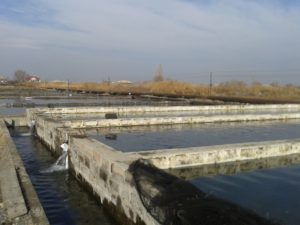 The Ararat Valley of Armenia represents the most significant reserve of the groundwater resources of the country. The groundwater extraction in the Ararat Valley has reached unprecedented level in the recent decade, having caused the reduction of the artesian zone by more than 60%. The groundwater level dropped by 9 meters on average, thus leading to tremendous water shortage in the Valley. This overuse of water was largely accounted for by the extensive spread of fish farms in the area. For many years, the fish farms have been using high-quality groundwater in fish production without proper regulation and control.
The Ararat Valley of Armenia represents the most significant reserve of the groundwater resources of the country. The groundwater extraction in the Ararat Valley has reached unprecedented level in the recent decade, having caused the reduction of the artesian zone by more than 60%. The groundwater level dropped by 9 meters on average, thus leading to tremendous water shortage in the Valley. This overuse of water was largely accounted for by the extensive spread of fish farms in the area. For many years, the fish farms have been using high-quality groundwater in fish production without proper regulation and control.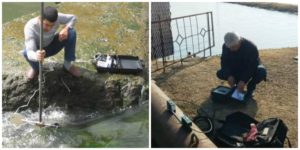 On December 16, USAID’s Advanced Science and Partnerships for Integrated Resource Development Project (ASPIRED) organized the presentation of the final results of the inventory of the wells, natural springs and fisheries in the Ararat Valley. The inventory was conducted by the Hydrogeological Monitoring Center of the Ministry of Nature Protection with an attempt to obtain the data on the groundwater resource use and the actual volume of water abstraction at different water use points. The inventory is a critical step towards establishing publicly accessible database on the groundwater resources and supporting the data-driven decision making by the Government.
On December 16, USAID’s Advanced Science and Partnerships for Integrated Resource Development Project (ASPIRED) organized the presentation of the final results of the inventory of the wells, natural springs and fisheries in the Ararat Valley. The inventory was conducted by the Hydrogeological Monitoring Center of the Ministry of Nature Protection with an attempt to obtain the data on the groundwater resource use and the actual volume of water abstraction at different water use points. The inventory is a critical step towards establishing publicly accessible database on the groundwater resources and supporting the data-driven decision making by the Government.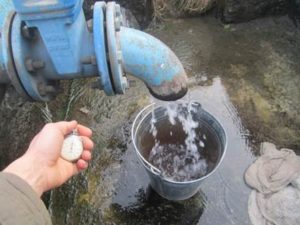
 On November 9, the USAID Advanced Science and Partnerships for Integrated Resource Development Project (ASPIRED) organized the policy workshop to discuss the current situation with the groundwater resources in the Ararat Valley. The USAID Mission Director Deborah Grieser, the Minister, Chief of Staff Davit Harutyunyan, the Deputy-Ministers of Nature Protection, Agriculture, Energy Infrastructures and Natural Resources, other decision-makers, public and private sector representatives attended the event. In her opening remarks, the USAID Mission Director Deborah Grieser thanked the Government of Armenia and the stakeholders for continued partnership and commitment to promote water sector reforms and sustainable water management practices in Armenia. The Deputy Minister of Nature Protection Khachik Hakobyan emphasized that conservation of the groundwater resources of the Ararat Valley has strategic importance for the country and is among the priority issues the Government is tasked with.
On November 9, the USAID Advanced Science and Partnerships for Integrated Resource Development Project (ASPIRED) organized the policy workshop to discuss the current situation with the groundwater resources in the Ararat Valley. The USAID Mission Director Deborah Grieser, the Minister, Chief of Staff Davit Harutyunyan, the Deputy-Ministers of Nature Protection, Agriculture, Energy Infrastructures and Natural Resources, other decision-makers, public and private sector representatives attended the event. In her opening remarks, the USAID Mission Director Deborah Grieser thanked the Government of Armenia and the stakeholders for continued partnership and commitment to promote water sector reforms and sustainable water management practices in Armenia. The Deputy Minister of Nature Protection Khachik Hakobyan emphasized that conservation of the groundwater resources of the Ararat Valley has strategic importance for the country and is among the priority issues the Government is tasked with.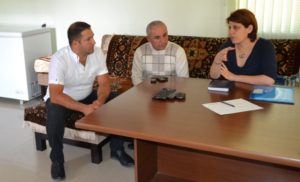
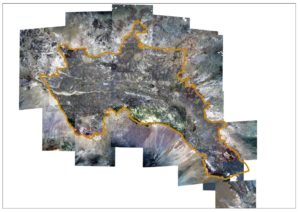 USAID’s Global Development Lab has been the reliable partner of the ASPIRED Project since the very beginning. Lab’s GeoCenter is a valuable source of technical data for the Project, the aim of which is to promote a more balanced and rational use of the groundwater resources of Ararat Valley.
USAID’s Global Development Lab has been the reliable partner of the ASPIRED Project since the very beginning. Lab’s GeoCenter is a valuable source of technical data for the Project, the aim of which is to promote a more balanced and rational use of the groundwater resources of Ararat Valley. ASPIRED project in collaboration with Environmental Research and GIS Center (ERGIS) NGO started implementation of the pilot project on rehabilitation of the irrigation network of Hayanist community. Outlet water from the nearby fishery will be used to irrigate 40 hectares of the community’s arable land. The project serves a dual purpose of partially resolving the irrigation issue of the community and increasing the efficiency of the artesian water use by the fishery which would be otherwise discharged into the drainage network.
ASPIRED project in collaboration with Environmental Research and GIS Center (ERGIS) NGO started implementation of the pilot project on rehabilitation of the irrigation network of Hayanist community. Outlet water from the nearby fishery will be used to irrigate 40 hectares of the community’s arable land. The project serves a dual purpose of partially resolving the irrigation issue of the community and increasing the efficiency of the artesian water use by the fishery which would be otherwise discharged into the drainage network.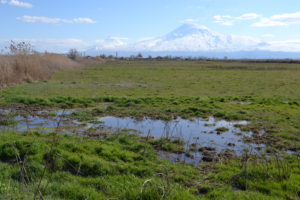 The ASPIRED and ERGIS specialists carefully examined the quality of feed used in the fishery and the discharged water based on the FAO standards to make sure water can be safely used for irrigation purposes and all environmental norms are observed.
The ASPIRED and ERGIS specialists carefully examined the quality of feed used in the fishery and the discharged water based on the FAO standards to make sure water can be safely used for irrigation purposes and all environmental norms are observed.